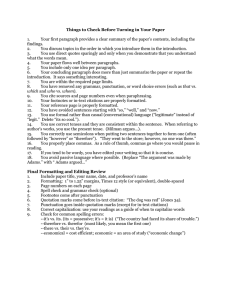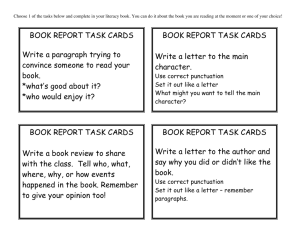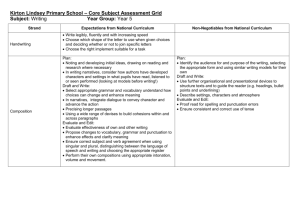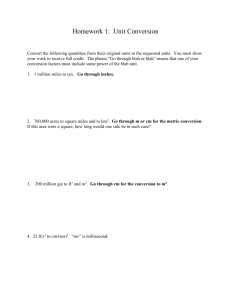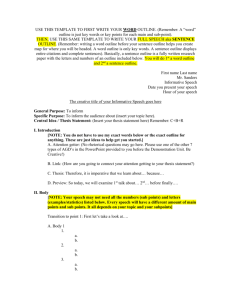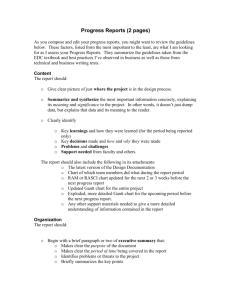writing reminders - Mona Shores Blogs
advertisement
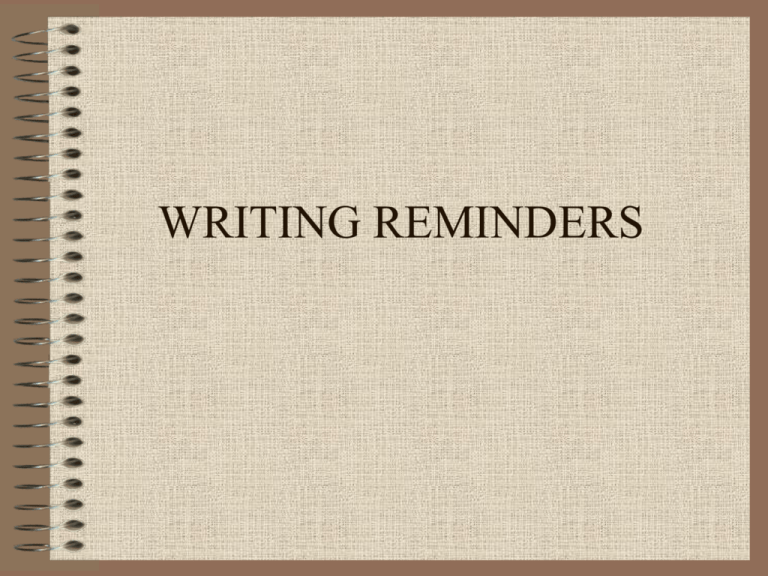
WRITING REMINDERS PURPOSE • As a writer ALWAYS know your PURPOSE. • Are you writing to summarize, paraphrase, inform, persuade, entertain, etc. • If you do not meet the purpose, then no matter how well-written-you have NOT DONE THE ASSIGNMENT! PURPOSE • For example: If I asked you to write me directions to get to the Lakes Mall and you wrote out a summary of the land development of the area that now is the Lakes Mall you have not met the purpose! As interesting as it may be-I still do not know HOW TO GET TO THE MALL! AVOID “I” • It is preferred practice to avoid “I” in formal writing, especially argumentative or persuasive (unless specifically instructed to write as a personal opinion paper.) • When presenting an argument you want to argue as fact-not opinion. While your opinion may have been your starting point, if your argument is strong enough it is based upon facts and evidence to prove its correctness, so argue as such. BOOK TITLES 1. Book titles should be in Italics (underlined when handwritten. (not in quotation marks) Of Mice and Men Of Mice and Men 2. Reference title and author in the introduction. 3. May refer to the author by last name only after full name is introduced the first time. CITATIONS • In-text MUST match the Work Cited including: – Spelling of author’s name – Punctuation of titles (in quotes or underlined/italicized) – Other punctuation (commas, etc.) not needed – Exception-use a ; when separating two citations within one set of parentheses • Example (Smith; Anderson 62) CITATIONS • Sample of matching title punctuation. Works Cited entry “Mandarin,” The Encyclopedia American, 1994 ed. In-text Blah blah blah (“Mandarin”) Works Cited entry MacCase. Vers. 1.0.1 Aug. 1998 ftp:///ftp.adfa.oz.au/pub/mac/MacCASE/. In-text Blah blah blah (MacCase) CITATIONS • When using only 1 resource to quote from you may use only the page number in parenthesis. You DO NOT need the letters pg. • Place the quotation mark before the citation parenthesis, not after. • End punctuation goes outside the parenthesis. Example: WRONG: “George didn’t answer, but he nodded slowly.(pg. 40)” RIGHT: “George didn’t answer, but he nodded slowly” (40). CITATIONS • When using a direct quotation that is longer than 5 typed lines you indent the entire quotation on both sides and eliminate the quotation marks. • See example next slide. CITATIONS-LONG QUOTES Steinbeck uses detailed description of setting to create imagery that relates to his larger themes as seen in this description: A water snake glided smoothly up the pool, twisting its perioscope head from side to side; and it swam the length of the pool and came to the legs of a motionless heron that stood in the shallows. A silent head and beak lanced down and plucked it out by the head, and the beak swallowed the little snake white its tail waved frantically (99). Continue your explanation back at the regular margins. CITATIONS & QUOTATIONS He replied, “I don’t care. ‘To die or not to die, that is the question’” (Smith). Has the phrase, “To be or not to be that is the question,” (Shakespeare) become trite? Did she often say, “I just don’t care anymore” (Smith)? “Did she often say, ‘I just don’t care anymore’?” (Smith). THE GRAMMAR REMINDERS THE PRONOUNS THAT VS. WHO WHO • WHO is used to indicate or in reference to a human. Example: My grandma, who bakes delicious cookies, is coming over for Mother’s Day. Additional notes: A. a comma is used before and after the who clause because it describes grandma but is not necessary to the sentence because we know it is your grandma. This is called a nonessential clause. B. Notice the apostrophe in Mother’s as it is possessing a particular day. THAT • THAT is used to indicate nonhumans or inanimate objects. Example: The dog that bit me is at the pound. The rock that was found by the little boy, weighed 10 pounds. PRACTICE 1. My teacher (that/who)went to Europe last summer, brought back cool souvenirs. 2. The car (that/who) my brother bought is rusty. 3. The tree (that/who) was planted last year grew eight feet. 4. The boy (that/who) spit on the sidewalk had to do community service. SINGULAR VS. PLURAL PRONOUN USAGE • Anyone, Everyone, Someone, Anybody, Everybody. • Most often people use “their” as the associated pronoun. For example, Everyone needs to bring their book to class. This is incorrect. Everyone needs to bring her book to class. All students must bring their book to class. PUNCTUATION • NEVER use commas with “because” or “that” • ALWAYS use commas with “especially” PUNCTUATION • To avoid run-on sentences use proper punctuation: (of course you can always use a period, otherwise use the following rules) – Comma before a conjunction in two complete ideas • She wanted the children to learn to use their manners, so she decided to take a parenting course to help her learn the best methods of instruction. – Semi-colon between two complete thoughts if no conjunction. • He wrestled for weeks with himself trying to get the courage to ask her out; courage finally won. WORD USAGE • • • • • It’s vs. Its Their, There, They’re To vs. Too Than vs. Then Every day vs. Everyday • Loose vs. Lose • Whose vs. Who’s • A lot=always two words • Never use alright-use all right • Fewer vs. Less • Anyways is NOT A WORD. The word is anyway! • Never use “these ones” it is only “these” Never use COULD OF MUST OF SHOULD OF WOULD OF • These are not standard English. • DO NOT EVER USE! • All should be expressed with the helping verb “have” • Could have • Must have • Should have • Would have
